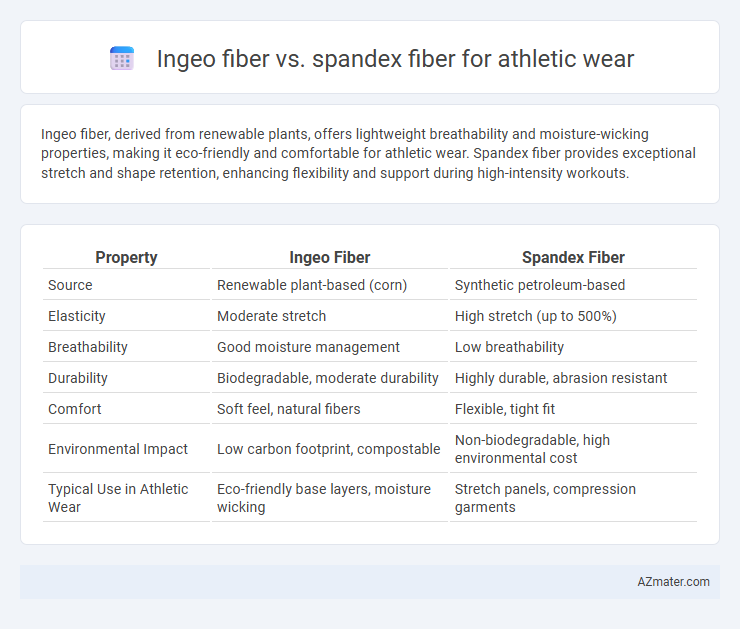Ingeo fiber, derived from renewable plants, offers lightweight breathability and moisture-wicking properties, making it eco-friendly and comfortable for athletic wear. Spandex fiber provides exceptional stretch and shape retention, enhancing flexibility and support during high-intensity workouts.
Table of Comparison
| Property | Ingeo Fiber | Spandex Fiber |
|---|---|---|
| Source | Renewable plant-based (corn) | Synthetic petroleum-based |
| Elasticity | Moderate stretch | High stretch (up to 500%) |
| Breathability | Good moisture management | Low breathability |
| Durability | Biodegradable, moderate durability | Highly durable, abrasion resistant |
| Comfort | Soft feel, natural fibers | Flexible, tight fit |
| Environmental Impact | Low carbon footprint, compostable | Non-biodegradable, high environmental cost |
| Typical Use in Athletic Wear | Eco-friendly base layers, moisture wicking | Stretch panels, compression garments |
Introduction to Ingeo and Spandex Fibers
Ingeo fiber, derived from renewable plant-based resources like corn, offers biodegradable and moisture-wicking properties ideal for sustainable athletic wear. Spandex fiber, known for its exceptional elasticity and stretch recovery, provides superior flexibility and shape retention in activewear garments. Combining Ingeo's eco-friendly performance with Spandex's stretchability enhances comfort and durability in sports apparel.
Composition and Origin of Ingeo vs Spandex Fibers
Ingeo fiber, derived from renewable plant-based sources such as corn starch through a fermentation process, offers a sustainable alternative to synthetic fibers, emphasizing biodegradability and reduced carbon footprint. Spandex fiber, a synthetic polyurethane polymer, is manufactured through chemical synthesis primarily from petrochemical raw materials, providing exceptional elasticity and stretch recovery essential for athletic wear. The natural origin of Ingeo contrasts with the petrochemical basis of Spandex, influencing performance characteristics and environmental impact in sports apparel.
Sustainability and Environmental Impact
Ingeo fiber, derived from renewable plant-based resources like corn, offers a significantly lower carbon footprint and biodegradability compared to conventional Spandex, which is a petroleum-based synthetic fiber with limited recyclability. Ingeo fibers support circular fashion by reducing reliance on fossil fuels and minimizing microplastic pollution, while Spandex contributes to environmental concerns due to its non-biodegradable nature and chemical-intensive production process. Choosing Ingeo fiber in athletic wear enhances sustainability by promoting eco-friendly material cycles and lowering overall environmental impact in textile manufacturing.
Breathability and Moisture-Wicking Properties
Ingeo fiber, derived from renewable plant-based materials, offers excellent breathability and superior moisture-wicking properties, making it ideal for athletic wear that requires temperature regulation and comfort. Spandex fiber excels in elasticity and flexibility but lacks the natural breathability and moisture management found in Ingeo fibers. Combining Ingeo with Spandex enhances athletic garments by providing both moisture control and stretchability.
Comfort and Softness in Athletic Wear
Ingeo fiber, derived from renewable plant materials, offers exceptional breathability and moisture-wicking properties, enhancing comfort in athletic wear by keeping the skin dry and cool. Spandex fiber provides superior stretch and elasticity, allowing for a snug but flexible fit that supports dynamic movement during workouts. Combining Ingeo's natural softness with Spandex's stretch creates athletic wear that maximizes both comfort and performance.
Durability and Strength Comparison
Ingeo fiber, derived from renewable plant-based sources, offers moderate durability and strength suitable for lightweight athletic wear but tends to lack the high tensile strength and elasticity required for intense physical activity. Spandex fiber, known for exceptional stretch and recovery, provides superior durability and strength critical for maintaining garment shape and resistance to wear during rigorous workouts. Combining Ingeo with spandex enhances eco-friendly athletic wear by balancing natural fiber comfort with the robust elasticity and resilience of spandex.
Stretchability and Flexibility Performance
Ingeo fiber offers moderate stretchability with natural elasticity suitable for lightweight, breathable athletic wear, but lacks the high stretch recovery found in spandex. Spandex fiber excels in flexibility performance, providing superior stretch and rebound, essential for tight-fitting, high-mobility sports apparel. Combining Ingeo with spandex enhances moisture-wicking and sustainability while maintaining optimal elasticity and flexibility for rigorous athletic activities.
Allergenicity and Skin Sensitivity
Ingeo fiber, derived from renewable plant-based sources, is naturally hypoallergenic and breathable, reducing the risk of skin irritation and allergic reactions in athletic wear. Spandex fiber, although highly elastic and flexible, can sometimes cause skin sensitivity or allergic responses due to its synthetic composition and chemical treatments. Choosing Ingeo fiber for athletic garments benefits individuals with sensitive skin by providing moisture-wicking properties and a softer, irritation-free experience compared to the potential allergenic concerns associated with Spandex.
Cost-Effectiveness and Market Availability
Ingeo fiber offers a cost-effective alternative to traditional Spandex fiber in athletic wear due to its renewable bio-based origin and competitive pricing as sustainable materials gain market traction. Spandex remains widely available and favored for its superior stretch and durability, but its petroleum-based production can lead to higher costs and environmental concerns. Market availability for Ingeo is rapidly expanding with increasing consumer demand for eco-friendly fabrics, making it a viable option for athletic wear brands seeking sustainability without significantly increasing costs.
Final Verdict: Choosing the Best Fiber for Athletic Wear
Ingeo fiber, derived from renewable plant-based materials, offers excellent moisture management, breathability, and biodegradability, making it a sustainable option for athletic wear. Spandex fiber is renowned for its superior stretch, flexibility, and shape retention, crucial for high-performance and form-fitting sports apparel. The best choice depends on the specific athletic needs: Ingeo suits eco-conscious consumers prioritizing comfort and sustainability, while Spandex excels in providing unmatched elasticity and durability for intense physical activities.

Infographic: Ingeo fiber vs Spandex fiber for Athletic wear
 azmater.com
azmater.com